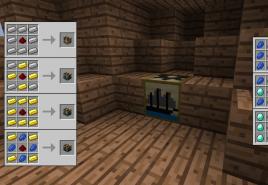Monomers of complex carbohydrates are. Carbohydrates
Carbohydrates
Turning to the consideration of organic substances, it is impossible not to note the importance of carbon for life. Entering into chemical reactions, carbon forms strong covalent bonds, socializing four electrons. Carbon atoms, connecting with each other, are able to form stable chains and rings that serve as the skeletons of macromolecules. Carbon can also form multiple covalent bonds with other carbon atoms, as well as with nitrogen and oxygen. All these properties provide a unique variety of organic molecules.
Macromolecules, which make up about 90% of the mass of a dehydrated cell, are synthesized from simpler molecules called monomers. There are three main types of macromolecules: polysaccharides, proteins, and nucleic acids; monomers for them are, respectively, monosaccharides, amino acids and nucleotides.
Carbohydrates are called substances with the general formula C x (H 2 O) y, where x and y are natural numbers. The name "carbohydrates" indicates that in their molecules hydrogen and oxygen are in the same ratio as in water.
Animal cells contain a small amount of carbohydrates, and plant cells contain almost 70% of the total amount of organic matter.
Monosaccharides play the role of intermediate products in the processes of respiration and photosynthesis, are involved in the synthesis of nucleic acids, coenzymes, ATP and polysaccharides, and are released during oxidation during respiration. Derivatives of monosaccharides - sugar alcohols, sugar acids, deoxysugars and amino sugars - are important in the process of respiration, and are also used in the synthesis of lipids, DNA and other macromolecules.
Disaccharides are formed by a condensation reaction between two monosaccharides. They are sometimes used as reserve nutrients. The most common of these are maltose (glucose + glucose), lactose (glucose + galactose) and sucrose (glucose + fructose). found only in milk. (cane sugar) most abundant in plants; this is the same "sugar" that we usually eat.
Cellulose is also a polymer of glucose. It contains about 50% of the carbon contained in plants. In terms of total mass on Earth, cellulose ranks first among organic compounds. The shape of the molecule (long chains with protruding –OH groups) provides a strong bond between adjacent chains. For all their strength, macrofibrils consisting of such chains easily pass water and substances dissolved in it and therefore serve as an ideal building material for plant cell walls. Cellulose is a valuable source of glucose, but its breakdown requires the cellulase enzyme, which is relatively rare in nature. Therefore, only some animals (for example, ruminants) eat cellulose. The industrial value of cellulose is also great - cotton fabrics and paper are made from this substance.
All carbohydrates are made up of individual "units", which are saccharides. By ability tohydrolysison themonomerscarbohydrates are dividedinto two groups: simple and complex. Carbohydrates containing one unit are calledmonosaccharides, two units -disaccharides, two to ten unitsoligosaccharides, and more than tenpolysaccharides.
Monosaccharides quickly increase blood sugar, and have a high glycemic index, so they are also called fast carbohydrates. They dissolve easily in water and are synthesized in green plants.
Carbohydrates consisting of 3 or more units are calledcomplex. Foods rich in complex carbohydrates gradually increase their glucose content and have a low glycemic index, which is why they are also called slow carbohydrates. Complex carbohydrates are products of polycondensation of simple sugars (monosaccharides) and, unlike simple ones, in the process of hydrolytic cleavage they are able to decompose into monomers, with the formation of hundreds and thousandsmoleculesmonosaccharides.
Stereoisomerism of monosaccharides: isomerglyceraldehydein which, when the model is projected onto the plane, the OH group at the asymmetric carbon atom is located on the right side, it is customary to consider D-glyceraldehyde, and the mirror image is L-glyceraldehyde. All isomers of monosaccharides are divided into D- and L-forms according to the similarity of the location of the OH group at the last asymmetric carbon atom near CH 2 OH groups (ketoses contain one asymmetric carbon atom less than aldoses with the same number of carbon atoms). Naturalhexoses – glucose, fructose, mannoseAndgalactose- according to stereochemical configurations, they are classified as D-series compounds.
Polysaccharides - the general name of the class of complex high-molecular carbohydrates,moleculesconsisting of tens, hundreds or thousandsmonomers – monosaccharides. From the point of view of the general principles of structure in the group of polysaccharides, it is possible to distinguish between homopolysaccharides synthesized from the same type of monosaccharide units and heteropolysaccharides, which are characterized by the presence of two or more types of monomeric residues.

https :// en . wikipedia . org / wiki /Carbohydrates
1.6. Lipids - nomenclature and structure. Lipid polymorphism.
Lipids - an extensive group of natural organic compounds, including fats and fat-like substances. Simple lipid molecules are composed of alcohol andfatty acids, complex - from alcohol, high molecular weight fatty acids and other components.
Lipid classification
Simple lipids are lipids that include carbon (C), hydrogen (H) and oxygen (O) in their structure.
Complex lipids - These are lipids that include in their structure, in addition to carbon (C), hydrogen (H) and oxygen (O), and other chemical elements. Most often: phosphorus (P), sulfur (S), nitrogen (N).

https:// en. wikipedia. org/ wiki/Lipids
Literature:
1) Cherkasova L. S., Merezhinsky M. F., Metabolism of fats and lipids, Minsk, 1961;
2) Markman A. L., Chemistry of lipids, v. 12, Tash., 1963 - 70;
3) Tyutyunnikov B. N., Chemistry of fats, M., 1966;
4) Mahler G., Kordes K., Fundamentals of biological chemistry, trans. from English, M., 1970.
1.7. biological membranes. Forms of lipid aggregation. The concept of the liquid-crystal state. Lateral diffusion and flip flops.
membranes delimit the cytoplasm from the environment, and also form the membranes of the nuclei, mitochondria and plastids. They form a labyrinth of the endoplasmic reticulum and flattened stacked vesicles that make up the Golgi complex. The membranes form lysosomes, large and small vacuoles of plant and fungal cells, pulsating vacuoles of protozoa. All these structures are compartments (compartments) designed for certain specialized processes and cycles. Therefore, without membranes, the existence of a cell is impossible.

Diagram of the structure of the membrane: a – three-dimensional model; b - planar image;
1 - proteins adjacent to the lipid layer (A), immersed in it (B) or penetrating it through (C); 2 - layers of lipid molecules; 3 - glycoproteins; 4 - glycolipids; 5 - hydrophilic channel functioning as a pore.
The functions of biological membranes are as follows:
1) Delimit the contents of the cell from the external environment and the contents of the organelles from the cytoplasm.
2) Provide transport of substances into and out of the cell, from the cytoplasm to the organelles and vice versa.
3) They act as receptors (receiving and converting signals from the environment, recognition of cell substances, etc.).
4) They are catalysts (ensuring near-membrane chemical processes).
5) Participate in the transformation of energy.
http:// sbio. info/ page. php? id=15
Lateral diffusion is the chaotic thermal movement of lipid and protein molecules in the plane of the membrane. With lateral diffusion, adjacent lipid molecules jump around, and as a result of such successive jumps from one place to another, the molecule moves along the membrane surface.
The movement of molecules along the surface of the cell membrane during time t was determined experimentally by the method of fluorescent labels - fluorescent molecular groups. Fluorescent labels make fluorescent molecules, the movement of which on the cell surface can be studied, for example, by examining under a microscope the spreading rate of the fluorescent spot created by such molecules on the cell surface.
flip flop is the diffusion of membrane phospholipid molecules across the membrane.
The rate of jumps of molecules from one surface of the membrane to another (flip-flop) was determined by the spin label method in experiments on model lipid membranes - liposomes.
Some of the phospholipid molecules from which liposomes were formed were labeled with spin labels attached to them. Liposomes were exposed to ascorbic acid, as a result of which unpaired electrons on the molecules disappeared: paramagnetic molecules became diamagnetic, which could be detected by a decrease in the area under the curve of the EPR spectrum.
Thus, jumps of molecules from one surface of a bilayer to another (flip-flop) occur much more slowly than jumps during lateral diffusion. The average time for a phospholipid molecule to flip-flop (T ~ 1 hour) is tens of billions of times longer than the average time for a molecule to jump from one place to another in the membrane plane.
The concept of the liquid-crystal state
The solid body can becrystalline , andamorphous. In the first case, there is a long-range order in the arrangement of particles at distances much greater than the intermolecular distances (crystal lattice). In the second, there is no long-range order in the arrangement of atoms and molecules.
The difference between an amorphous body and a liquid is not in the presence or absence of long-range order, but in the nature of particle motion. The molecules of a liquid and a solid make oscillatory (sometimes rotational) motions around the equilibrium position. After some average time (“time of settled life”), the molecules jump to another equilibrium position. The difference is that the "settled time" in a liquid is much shorter than in a solid state.
Lipid bilayer membranes are liquid under physiological conditions, the “settled life time” of a phospholipid molecule in the membrane is 10 −7 – 10 −8 from.
Molecules in the membrane are not randomly arranged; long-range order is observed in their arrangement. Phospholipid molecules are in a double layer, and their hydrophobic tails are approximately parallel to each other. There is also order in the orientation of the polar hydrophilic heads.
The physiological state in which there is a long-range order in the mutual orientation and arrangement of molecules, but the state of aggregation is liquid, is calledliquid crystal state. Liquid crystals can form not in all substances, but in substances from "long molecules" (the transverse dimensions of which are smaller than the longitudinal ones). There may be various liquid crystal structures: nematic (filamentous), when long molecules are oriented parallel to each other; smectic - molecules are parallel to each other and arranged in layers; cholestic - the molecules are parallel to each other in the same plane, but in different planes the orientations of the molecules are different.
http:// www. studfiles. en/ preview/1350293/
Literature: ON THE. Lemeza, L.V. Kamlyuk, N.D. Lisov. "Biology manual for applicants to universities."
1.8. Nucleic acids. Heterocyclic bases, nucleosides, nucleotides, nomenclature. Spatial structure of nucleic acids - DNA, RNA (tRNA, rRNA, mRNA). Ribosomes and the cell nucleus. Methods for determining the primary and secondary structure of nucleic acids (sequencing, hybridization).
Nucleic acids - phosphorus-containing biopolymers of living organisms that provide storage and transmission of hereditary information.
Nucleic acids are biopolymers. Their macromolecules consist of repeatedly repeating units, which are represented by nucleotides. And they are logically namedpolynucleotides. One of the main characteristics of nucleic acids is their nucleotide composition. The composition of a nucleotide (a structural unit of nucleic acids) includesthree components:
– nitrogenous base. May be pyrimidine or purine. Nucleic acids contain 4 different types of bases: two of them belong to the class of purines and two belong to the class of pyrimidines.
– rest of phosphoric acid.
– Monosaccharide - ribose or 2-deoxyribose. Sugar, which is part of the nucleotide, contains five carbon atoms, i.e. is a pentose. Depending on the type of pentose present in the nucleotide, two types of nucleic acids are distinguished- ribonucleic acids (RNA), which contain ribose, anddeoxyribonucleic acids (DNA), containing deoxyribose.
Nucleotide at its core, it is the phosphate ester of the nucleoside.The composition of the nucleoside There are two components: a monosaccharide (ribose or deoxyribose) and a nitrogenous base.
http :// sbio . info / page . php ? id =11
Nitrogenous bases – heterocyclicorganic compounds, derivativespyrimidineAndpurine, included innucleic acids. For the abbreviated designation, capital Latin letters are used. The nitrogenous bases areadenine(A)guanine(G)cytosine(C) which are part of both DNA and RNA.Timin(T) is only part of DNA, anduracil(U) occurs only in RNA.
1. Give definitions of concepts.
Carbohydrates- organic substances containing a carbonyl group and several hydroxyl groups.
Monosaccharide
- a simple carbohydrate that does not break down into simpler compounds during hydrolysis.
disaccharide- a carbohydrate, which is a compound of two monosaccharides.
2. Complete the scheme "Diversity of carbohydrates in the cell."
3. Consider figure 11 of the textbook and give examples of monosaccharides, which include:
five carbon atoms: ribose, deoxyribose;
six carbon atoms: glucose, fructose.
4. Fill in the table.
Biological functions of mono- and disaccharides

5. Name water-soluble carbohydrates. What features of the structure of their molecules provide the property of solubility?
Monosaccharides (glucose, fructose) and disaccharides (sucrose). Their molecules are small and polar, therefore soluble in water. Polysaccharides form long chains that do not dissolve in water
6. Fill in the table.
BIOLOGICAL FUNCTIONS OF POLYSACCHARIDES

7. The polysaccharide chitin is part of the structure of the cell walls of fungi and forms the basis of the external skeleton of arthropods. Which of the known polysaccharides does it show functional similarity with? Justify the answer.
Chitin is a substance very similar in structure, physicochemical properties and biological role to cellulose. It performs protective and supporting functions, is contained in the cell walls of fungi, some algae, bacteria.
8. Give definitions of concepts.
Polypeptide- a chemical substance consisting of a long chain of amino acids linked by peptide bonds.
Denaturation
- loss by proteins or nucleic acids of their natural properties due to a violation of the spatial structure of their molecules.
Renaturation
- restoration (after denaturation) of the biologically active spatial structure of the biopolymer (protein or nucleic acid).
9. Explain the statement: "Proteins are carriers and organizers of life."
According to Engels, “Wherever we meet life, it is associated with some protein body, and wherever we meet any protein body that is not in the process of decomposition, we, without exception, meet the phenomena of life ...”. "Life is a way of existence of protein bodies...".
10. Write the general structural formula of an amino acid. Explain why a protein monomer is called that.
RCH(NH2)COOH. Amino acids combine the properties of acids and amines, that is, they contain, along with the carboxyl group -COOH, the amino group -NH2.
11. How do different amino acids differ from each other?
Amino acids differ from each other in the structure of the radical.
12. Fill in the cluster "Diversity of proteins and their functions".
Proteins: hormones, transport proteins, enzymes, toxins, antibiotics, storage proteins, protective proteins, motor proteins, structural proteins.
13. Finish filling in the table.

14. Using a textbook, explain the essence of the statement: "Biochemical reactions occurring in the presence of enzymes are the basis of cell vital activity."
Enzyme proteins catalyze many reactions, ensure the coherence of the cell ensemble of living organisms, accelerating the rate of chemical reactions many times over.
15. Give examples of proteins involved in the listed processes.
Running, walking, jumping - actin and myosin.
Growth is somatotropin.
The transport of oxygen and carbon dioxide in the blood is hemoglobin.
The growth of nails and hair is keratin.
Blood clotting - prothrombin, fibrinogen.
Oxygen binding in muscles - myoglobin.
16. Establish a correspondence between specific proteins and their functions.
1. Prothrombin
2. Collagen
3. Actin
4. Somatotropin
5. Hemoglobin
6. Insulin
Role in the body
A. Muscle contractile protein
B. Pituitary hormone
B. Provides blood clotting
G. Included in connective tissue fibers
D. Pancreatic hormone
E. Carries oxygen
17. What is the disinfectant property of ethyl alcohol based on?
It destroys proteins (including toxins) of bacteria, leads to their denaturation.
18. Why does a boiled egg immersed in cold water not return to its original state?
Irreversible denaturation of chicken egg protein occurs under the influence of high temperature.
19. When oxidizing 1 g of proteins, the same amount of energy is released as when oxidizing 1 g of carbohydrates. Why does the body use proteins as a source of energy only in extreme cases?
The functions of proteins are, firstly, building, enzymatic, transport functions, and only in extreme cases the body uses or spends proteins for energy, only when carbohydrates and fats do not enter the body, when the body is starving.
20. Choose the correct answer.
Test 1
Proteins that increase the rate of chemical reactions in the cell:
2) enzymes;
Test 2
The monomer of complex carbohydrates is:
4) glucose.
Test 3
Carbohydrates in the cell do not perform the function:
3) storage of hereditary information.
Test 4
A polymer whose monomers are arranged in a single line:
2) unbranched polymer;
Test 5
Amino acids do not include:
3) phosphorus;
Test 6
Animals have glycogen, while plants have:
3) starch;
Test 7
Hemoglobin has, but lysozyme does not:
4) quaternary structure.
21. Explain the origin and general meaning of the word (term), based on the meaning of the roots that make it up.

22. Choose a term and explain how its modern meaning corresponds to the original meaning of its roots.
Chosen term: deoxyribose.
Match: The term matches the meaning. This deoxysugar is a derivative of ribose, where the hydroxyl group at the second carbon atom is replaced by hydrogen with the loss of an oxygen atom (deoxy is the absence of an oxygen atom).
23. Formulate and write down the main ideas of § 2.5.
Carbohydrates and proteins are organic substances of the cell. Carbohydrates include: monosaccharides (ribose, deoxyribose, glucose), disaccharides (sucrose), polysaccharides (starch, glycogen, cellulose, chitin). In the body, they perform the following functions: energy, storage, structural.
Proteins whose monomers are amino acids have primary, secondary, tertiary, and often quaternary structures. They perform important functions in the body: they are hormones, enzymes, toxins, antibiotics, reserve, protective, transport, motor and structural proteins.
Carbohydrates- organic compounds, the composition of which in most cases is expressed by the general formula C n(H2O) m (n And m≥ 4). Carbohydrates are divided into monosaccharides, oligosaccharides and polysaccharides.
Monosaccharides- simple carbohydrates, depending on the number of carbon atoms, are divided into trioses (3), tetroses (4), pentoses (5), hexoses (6) and heptoses (7 atoms). The most common are pentoses and hexoses. Properties of monosaccharides- easily soluble in water, crystallize, have a sweet taste, can be presented in the form of α- or β-isomers.
Ribose and deoxyribose belong to the group of pentoses, are part of the RNA and DNA nucleotides, ribonucleoside triphosphates and deoxyribonucleoside triphosphates, etc. Deoxyribose (C 5 H 10 O 4) differs from ribose (C 5 H 10 O 5) in that it has a hydrogen atom at the second carbon atom, not a hydroxyl group like ribose.
Glucose or grape sugar(C 6 H 12 O 6), belongs to the group of hexoses, can exist in the form of α-glucose or β-glucose. The difference between these spatial isomers is that at the first carbon atom in α-glucose the hydroxyl group is located under the plane of the ring, while in β-glucose it is above the plane.
Glucose is:
- one of the most common monosaccharides,
- the most important source of energy for all types of work occurring in the cell (this energy is released during the oxidation of glucose during respiration),
- monomer of many oligosaccharides and polysaccharides,
- an essential component of blood.
Fructose or fruit sugar, belongs to the group of hexoses, sweeter than glucose, found in free form in honey (more than 50%) and fruits. It is a monomer of many oligosaccharides and polysaccharides.
Oligosaccharides- carbohydrates formed as a result of a condensation reaction between several (from two to ten) monosaccharide molecules. Depending on the number of monosaccharide residues, disaccharides, trisaccharides, etc. are distinguished. Disaccharides are the most common. Properties of oligosaccharides- dissolve in water, crystallize, the sweet taste decreases as the number of monosaccharide residues increases. The bond formed between two monosaccharides is called glycosidic.
Sucrose or cane or beet sugar, is a disaccharide consisting of glucose and fructose residues. Found in plant tissues. It is a food product (common name - sugar). In industry, sucrose is produced from sugar cane (stems contain 10-18%) or sugar beets (root crops contain up to 20% sucrose).
Maltose or malt sugar, is a disaccharide consisting of two glucose residues. Present in germinating seeds of cereals.
Lactose or milk sugar, is a disaccharide consisting of glucose and galactose residues. Present in the milk of all mammals (2-8.5%).
Polysaccharides- these are carbohydrates formed as a result of the polycondensation reaction of a multitude (several tens or more) of monosaccharide molecules. Properties of polysaccharides- do not dissolve or dissolve poorly in water, do not form clearly formed crystals, do not have a sweet taste.
Starch(C 6 H 10 O 5) n is a polymer whose monomer is α-glucose. Starch polymer chains contain branched (amylopectin, 1,6-glycosidic bonds) and unbranched (amylose, 1,4-glycosidic bonds) sections. Starch is the main reserve carbohydrate of plants, is one of the products of photosynthesis, accumulates in seeds, tubers, rhizomes, bulbs. The starch content in rice grains is up to 86%, wheat - up to 75%, corn - up to 72%, in potato tubers - up to 25%. Starch is the main carbohydrate human food (digestive enzyme - amylase).
Glycogen(C 6 H 10 O 5) n- a polymer, the monomer of which is also α-glucose. The polymeric chains of glycogen resemble the amylopectin sections of starch, but unlike them, they branch even more strongly. Glycogen is the main reserve carbohydrate of animals, in particular humans. Accumulates in the liver (content - up to 20%) and muscles (up to 4%), is a source of glucose.
(C 6 H 10 O 5) n is a polymer whose monomer is β-glucose. Cellulose polymer chains do not branch (β-1,4-glycosidic bonds). The main structural polysaccharide of plant cell walls. The cellulose content in wood is up to 50%, in the fibers of cotton seeds - up to 98%. Cellulose is not broken down by human digestive juices, because. it lacks the enzyme cellulase, which breaks bonds between β-glucoses.
Inulin is a polymer whose monomer is fructose. Reserve carbohydrate of plants of the Compositae family.
Glycolipids- complex substances formed as a result of the combination of carbohydrates and lipids.
Glycoproteins- complex substances formed as a result of the combination of carbohydrates and proteins.
Functions of carbohydrates
The structure and function of lipids
Lipids do not have a single chemical characteristic. In most benefits, giving lipid determination, they say that this is a combined group of water-insoluble organic compounds that can be extracted from the cell with organic solvents - ether, chloroform and benzene. Lipids can be divided into simple and complex.
Simple lipids in the majority are esters of higher fatty acids and trihydric alcohol glycerol - triglycerides. Fatty acid have: 1) the same grouping for all acids - a carboxyl group (-COOH) and 2) a radical by which they differ from each other. The radical is a chain of various numbers (from 14 to 22) groups -CH 2 -. Sometimes the fatty acid radical contains one or more double bonds (-CH=CH-), such fatty acid is called unsaturated. If a fatty acid has no double bonds, it is called rich. In the formation of triglyceride, each of the three hydroxyl groups of glycerol undergoes a condensation reaction with a fatty acid to form three ester bonds.
If triglycerides are dominated by saturated fatty acids, then at 20°C they are solid; they are called fats, they are characteristic of animal cells. If triglycerides are dominated by unsaturated fatty acids, then at 20 °C they are liquid; they are called oils, they are characteristic of plant cells.
1 - triglyceride; 2 - ester bond; 3 - unsaturated fatty acid;
4 - hydrophilic head; 5 - hydrophobic tail.
The density of triglycerides is lower than that of water, so they float in water, are on its surface.
Simple lipids also include waxes- esters of higher fatty acids and macromolecular alcohols (usually with an even number of carbon atoms).
Complex lipids. These include phospholipids, glycolipids, lipoproteins, etc.
Phospholipids- triglycerides in which one fatty acid residue is replaced by a phosphoric acid residue. They take part in the formation of cell membranes.
Glycolipids- see above.
Lipoproteins- complex substances formed as a result of the combination of lipids and proteins.
Lipoids- fat-like substances. These include carotenoids (photosynthetic pigments), steroid hormones (sex hormones, mineralocorticoids, glucocorticoids), gibberellins (plant growth substances), fat-soluble vitamins (A, D, E, K), cholesterol, camphor, etc.
Functions of lipids
| Function | Examples and explanations |
|---|---|
| Energy | The main function of triglycerides. When splitting 1 g of lipids, 38.9 kJ are released. |
| Structural | Phospholipids, glycolipids and lipoproteins are involved in the formation of cell membranes. |
| Reserve | Fats and oils are a reserve food substance in animals and plants. Important for animals that hibernate during the cold season or make long transitions through areas where there are no food sources. Plant seed oils are needed to provide energy to the seedling. |
| Protective | Layers of fat and fatty capsules provide shock absorption of internal organs. Layers of wax are used as a water-repellent coating in plants and animals. |
| Thermal insulation | Subcutaneous fatty tissue prevents the outflow of heat into the surrounding space. Important for aquatic mammals or mammals living in cold climates. |
| Regulatory | Gibberellins regulate plant growth. The sex hormone testosterone is responsible for the development of male secondary sexual characteristics. The sex hormone estrogen is responsible for the development of female secondary sexual characteristics and regulates the menstrual cycle. Mineralocorticoids (aldosterone, etc.) control water-salt metabolism. Glucocorticoids (cortisol, etc.) are involved in the regulation of carbohydrate and protein metabolism. |
| Source of metabolic water | When 1 kg of fat is oxidized, 1.1 kg of water is released. Important for desert dwellers. |
| catalytic | Fat-soluble vitamins A, D, E, K are enzyme cofactors, i.e. by themselves, these vitamins do not have catalytic activity, but without them, enzymes cannot perform their functions. |
Go to lectures number 1"Introduction. Chemical elements of the cell. Water and other inorganic compounds"
Go to lectures №3“The structure and function of proteins. Enzymes»
All carbohydrates are made up of individual "units", which are saccharides. According to the ability to hydrolyze into monomers, carbohydrates are divided into two groups: simple and complex. Carbohydrates containing one unit are called monosaccharides, two units are called disaccharides, from two to ten units are called oligosaccharides, and more than ten units are called polysaccharides. Monosaccharides quickly raise blood sugar levels and have a high glycemic index, which is why they are also called fast carbohydrates. They dissolve easily in water and are synthesized in green plants. Carbohydrates consisting of 3 or more units are called complex. Foods rich in complex carbohydrates gradually increase their glucose content and have a low glycemic index, which is why they are also called slow carbohydrates. Complex carbohydrates are products of polycondensation of simple sugars (monosaccharides) and, unlike simple ones, in the process of hydrolytic cleavage they are able to decompose into monomers with the formation of hundreds and thousands of monosaccharide molecules.
The most common monosaccharide in nature is beta-D-glucose.
Monosaccharides
Monosaccharides (from the Greek monos - the only one, sacchar - sugar) - the simplest carbohydrates that do not hydrolyze to form simpler carbohydrates - they are usually colorless, easily soluble in water, poorly in alcohol and completely insoluble in ether, solid transparent organic compounds, one of the main groups of carbohydrates, the simplest form of sugar. Aqueous solutions have a neutral pH. Some monosaccharides have a sweet taste. Monosaccharides contain a carbonyl (aldehyde or ketone) group, so they can be considered as derivatives of polyhydric alcohols. A monosaccharide with a carbonyl group at the end of the chain is an aldehyde and is called an aldose. At any other position of the carbonyl group, the monosaccharide is a ketone and is called ketose. Depending on the length of the carbon chain (from three to ten atoms), trioses, tetroses, pentoses, hexoses, heptoses, and so on are distinguished. Among them, pentoses and hexoses are the most widespread in nature. Monosaccharides are the building blocks from which disaccharides, oligosaccharides and polysaccharides are synthesized.
In nature, in free form, D-glucose (C6H12O6) is the most common - the structural unit of many disaccharides (maltose, sucrose and lactose) and polysaccharides (cellulose, starch). Other monosaccharides are generally known as components of di-, oligo- or polysaccharides and are rare in the free state. Natural polysaccharides are the main sources of monosaccharides.









